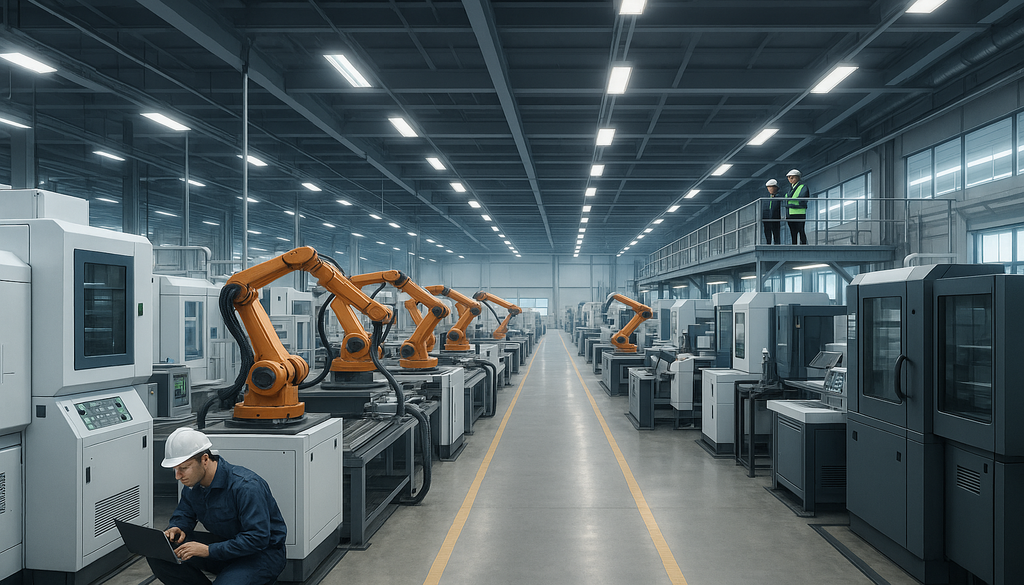Learn how Automated Storage and Retrieval Systems (AS/RS) can revolutionize your warehouse operations and maximize efficiency.
In today’s fast-paced and competitive business landscape, maximizing efficiency is essential for staying ahead. One way to achieve this is by implementing Automated Storage and Retrieval Systems (AS/RS). These advanced technological solutions can revolutionize your warehouse management and help streamline your operations. In this article, we will explore the various aspects of AS/RS and how they can enhance your business.
Understanding Automated Storage and Retrieval Systems (AS/RS)
Before we delve into the benefits of AS/RS, let’s first understand what they are. AS/RS is a computer-controlled system that automates the storage and retrieval of goods in a warehouse. It utilizes a combination of software, machinery, and intelligent control systems to efficiently manage inventory and optimize space utilization.
Imagine a bustling warehouse, filled with rows upon rows of neatly stacked products. In this dynamic environment, an AS/RS system acts as the silent conductor, orchestrating the intricate dance of goods. It ensures that every item is stored in the most efficient location, ready to be retrieved at a moment’s notice.
Key Components of AS/RS
An AS/RS typically consists of several key components, each playing a vital role in the smooth operation of the system:
- Storage and retrieval machines: These automated machines are like the workhorses of the AS/RS system. With precision and speed, they glide along the warehouse aisles, gracefully retrieving and storing products. Equipped with advanced technology, these machines are capable of handling various types of goods, from bulky pallets to delicate trays.
- Shuttles and conveyors: Picture a network of highways within the warehouse, connecting different areas seamlessly. Shuttles and conveyors are the vehicles that traverse these highways, transporting goods from one location to another. They ensure a smooth flow of inventory, eliminating bottlenecks and reducing the time it takes for products to reach their destination.
- Control software: The control software acts as the brain of the AS/RS, tirelessly managing and coordinating the movement of goods. It analyzes data, calculates optimal storage locations, and directs the machines and shuttles accordingly. With its intelligent algorithms, the control software ensures that every inch of warehouse space is utilized to its maximum potential.
- Sensors and scanners: In the world of AS/RS, precision is key. Sensors and scanners are the watchful eyes that monitor the location of goods, ensuring that every item is accounted for. They track inventory levels, alerting the system when it’s time to replenish stock. With their accuracy and efficiency, these devices contribute to the seamless operation of the AS/RS system.
Types of AS/RS
There are various types of AS/RS systems available, each designed to cater to different warehouse requirements. Let’s explore some common types:
- Unit Load AS/RS: Ideal for handling large and heavy items, this type of AS/RS utilizes sturdy pallets or durable totes for storage and retrieval. With their robust construction, these systems can handle the weight and size of bulky goods, ensuring efficient and safe storage.
- Mini Load AS/RS: When it comes to managing smaller items, precision is paramount. Mini Load AS/RS systems are specifically designed for this purpose. Using trays or bins, these systems carefully store and retrieve inventory, ensuring that every item is easily accessible and protected.
- Vertical Lift Modules (VLM): In a warehouse, space is a valuable commodity. VLMs are vertical, automated storage systems that make the most of the available vertical space. With their ingenious design, these modules optimize storage density, allowing warehouses to store more goods within a limited footprint.
- Carousel AS/RS: Imagine a mesmerizing carousel, gracefully spinning and bringing items directly to the operator. That’s the beauty of Carousel AS/RS systems. With rotating shelves or bins, these systems eliminate the need for operators to search for products, reducing picking time and increasing efficiency.
As you can see, AS/RS systems are a marvel of modern technology, revolutionizing the way warehouses operate. With their efficiency, accuracy, and space optimization capabilities, they are transforming the world of logistics, ensuring that goods flow seamlessly from storage to the hands of customers.

The Role of AS/RS in Warehouse Management
Now that we have a solid understanding of AS/RS, let’s explore how they can significantly improve warehouse management.
Automated Storage and Retrieval Systems (AS/RS) play a crucial role in modern warehouse management by revolutionizing the way inventory is stored, retrieved, and managed. These systems utilize advanced technology such as robotics, conveyors, and automated storage units to streamline warehouse operations and maximize efficiency.
Improving Inventory Control
Accurate inventory control is crucial for preventing stockouts, reducing excess inventory, and improving forecasting. AS/RS offers real-time visibility into stock levels and locations, ensuring better inventory accuracy and minimizing the risk of overstocking or understocking.
Furthermore, AS/RS systems can implement inventory tracking software that provides detailed insights into inventory turnover rates, demand patterns, and storage utilization. This data-driven approach enables warehouse managers to make informed decisions regarding inventory replenishment, storage layout optimization, and demand forecasting.
Enhancing Order Accuracy
With AS/RS, order picking becomes more efficient and accurate. The system guides warehouse employees through optimized picking routes, reducing errors and improving customer satisfaction. By minimizing picking mistakes, AS/RS helps avoid costly returns and re-shipments.
In addition to improving order accuracy, AS/RS can also enhance order fulfillment speed. By automating the retrieval and delivery of goods, these systems significantly reduce order processing times, enabling warehouses to meet tight delivery deadlines and enhance overall operational efficiency.
The Impact of AS/RS on Operational Efficiency
Implementing Automated Storage and Retrieval Systems (AS/RS) can have a profound and transformative impact on your operational efficiency. By seamlessly integrating cutting-edge technology into your warehouse management processes, AS/RS systems revolutionize the way goods are stored, retrieved, and managed.
One key benefit of AS/RS is the significant reduction in labor costs that organizations experience. By automating the storage and retrieval process, AS/RS eliminates the need for extensive manual labor, thereby streamlining operations and increasing overall efficiency. This not only leads to cost savings but also reduces the reliance on temporary workers, particularly during peak seasons or busy periods. With AS/RS in place, employees can redirect their focus towards more strategic and value-added tasks, such as quality control initiatives or process improvement projects, ultimately enhancing the overall productivity of the workforce.
Reducing Labor Costs
By automating the storage and retrieval process, AS/RS reduces the need for manual labor. This not only decreases labor costs but also minimizes the reliance on temporary workers during peak seasons. Employees can focus on higher-value tasks, such as quality control or process improvement.
Another critical advantage of AS/RS is its ability to significantly increase storage density within your warehouse facilities. By leveraging advanced storage technologies and innovative design principles, AS/RS systems optimize the utilization of available space, allowing organizations to store a larger volume of goods in a more compact and efficient manner.
Vertical storage systems, such as Vertical Lift Modules (VLMs), are particularly effective in maximizing vertical space, enabling businesses to store a greater number of products without the need for costly facility expansions. This enhanced storage density not only results in tangible cost savings for organizations but also drives improvements in overall productivity and operational efficiency.
Increasing Storage Density
AS/RS maximizes the utilization of the available space in your warehouse by efficiently storing items in a compact manner. Vertical storage systems, such as VLMs, optimize vertical space, allowing you to store more products without expanding your facility. This increased storage density leads to cost savings and improved productivity.

Implementing AS/RS in Your Business
When considering the implementation of Automated Storage and Retrieval Systems (AS/RS) in your business, there are several crucial factors that need to be assessed and addressed to ensure a successful integration.
Implementing AS/RS can revolutionize your warehouse operations by optimizing storage space, increasing efficiency, and reducing labor costs. However, to reap these benefits, a strategic approach is necessary.
Assessing Your Needs
Understanding your business requirements and warehouse characteristics is the foundational step in implementing AS/RS. Factors such as the volume and type of products you handle, order frequency, SKU variability, and space availability should be carefully evaluated. This comprehensive analysis will provide valuable insights into your operation’s specific needs and challenges, guiding the selection of the most suitable AS/RS system.
Moreover, assessing your current workflow processes and identifying areas that can be improved through automation is essential. By mapping out your existing operations and pinpointing bottlenecks or inefficiencies, you can tailor the AS/RS implementation to address these pain points effectively.
Choosing the Right AS/RS
Once you have conducted a thorough assessment of your needs, the next critical step is selecting the right AS/RS system for your business. Collaborating with experienced AS/RS providers and engaging in detailed discussions about your requirements can help you navigate the myriad of options available in the market.
Consideration should be given not only to the initial cost of the system but also its scalability, flexibility, maintenance requirements, and compatibility with your existing warehouse management software. Evaluating the track record of potential suppliers, including their installation processes, post-sales support, and system reliability, is paramount in ensuring a seamless integration and long-term success of your AS/RS solution.
Navigating Implementation Challenges of AS/RS
Implementing Automated Storage and Retrieval Systems (AS/RS) can significantly enhance warehouse efficiency and productivity. However, the journey to a fully automated storage and retrieval process is not without its hurdles. Understanding these challenges and preparing for them in advance can ensure a smoother transition and successful integration of AS/RS into your operations.
High Initial Investment
Challenge: One of the primary barriers to AS/RS implementation is the perceived high cost of initial investment. The expenses associated with purchasing and installing AS/RS can be substantial, making businesses hesitant to commit.
Solution: To mitigate this challenge, consider a phased implementation approach, starting with critical areas of your operation that would benefit most from automation. This strategy allows for the gradual allocation of resources, making the investment more manageable. Additionally, exploring financing options or leasing equipment can reduce upfront costs, while the long-term savings in labor and increased efficiency often justify the initial expenditure.
Integration with Existing Systems
Challenge: Ensuring that the new AS/RS seamlessly integrates with your existing warehouse management system (WMS) and other IT infrastructure can be complex. Incompatibilities can lead to operational disruptions and inefficiencies.
Solution: Early engagement with vendors who have proven experience in integrating AS/RS with various WMS platforms is crucial. Conduct thorough compatibility assessments and insist on a detailed integration plan from your AS/RS provider. Consider leveraging middleware solutions if direct integration poses significant challenges.
Space and Layout Constraints
Challenge: Warehouses with limited space or those not originally designed to accommodate AS/RS may face challenges in implementing these systems without significant modifications.
Solution: Work with AS/RS providers to design a customized solution that maximizes the use of available space. In some cases, vertical expansion (utilizing vertical lift modules, for example) can significantly increase storage capacity without the need for horizontal expansion. Engaging a warehouse design consultant can also provide innovative solutions to space constraints.
Workforce Adaptation and Training
Challenge: The transition to an automated system requires a shift in workforce roles and responsibilities. Employees may resist change due to fear of job loss or the belief that their skills may become obsolete.
Solution: Addressing workforce concerns through transparent communication is key. Highlight the benefits of AS/RS, such as the reduction of physically demanding tasks and the opportunity for staff to engage in more rewarding, higher-value work. Invest in comprehensive training programs to equip your team with the skills needed to operate and maintain the new system effectively.
Maintaining System Efficiency and Reliability
Challenge: Like any sophisticated machinery, AS/RS require regular maintenance to operate efficiently. System downtime can significantly impact operations, leading to delays and increased costs.
Solution: Establish a proactive maintenance schedule and train in-house staff to perform routine checks and minor repairs. Consider entering into a maintenance agreement with your AS/RS provider to ensure prompt service and support for more complex issues.

The Future of AS/RS
The world of AS/RS is continuously evolving, driven by technological advancements and sustainability considerations.
Technological Advancements in AS/RS
New technological developments, such as artificial intelligence and machine learning, are being incorporated into AS/RS systems. These advancements enhance efficiency, improve order accuracy, and offer predictive analytics, allowing businesses to optimize their warehouse operations further.
Sustainability and AS/RS
In an era of increasing environmental awareness, AS/RS plays an essential role in promoting sustainability. By optimizing storage density, minimizing energy consumption, and reducing waste, AS/RS contributes to more eco-friendly warehouse management practices.
As you can see, Automated Storage and Retrieval Systems have the potential to revolutionize warehouse management and maximize operational efficiency. By understanding the key components, types, and benefits of AS/RS, businesses can make informed decisions regarding implementation. With the continuous advancements in technology, the future of AS/RS looks promising, offering even greater potential for efficiency and sustainability.
Conclusion
Automated Storage and Retrieval Systems (AS/RS) are not just a component of modern warehouse operations; they are a cornerstone of efficiency and productivity in today’s fast-paced market. By intelligently automating storage and retrieval processes, AS/RS enable businesses to significantly enhance operational efficiency, reduce costs, and improve accuracy. As technology advances, the potential of AS/RS to drive innovation and sustainability in warehouse management continues to grow.
Whether you’re looking to optimize your existing operations or build a foundation for future growth, the implementation of AS/RS offers a proven pathway to achieving your objectives. With the right planning, selection, and integration, AS/RS can transform your warehouse into a model of efficiency and effectiveness.Ready to take your warehouse operations to the next level? ASC Software is here to guide you through every step of the process. Our ASCTrac® WCS and WMS are designed to seamlessly integrate with Automated Storage and Retrieval Systems, providing you with the tools you need to maximize efficiency, accuracy, and productivity. Don’t let complexity hold you back. Contact us today to discover how we can help you unlock the full potential of your warehouse operations with ASCTrac®.




